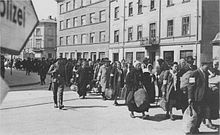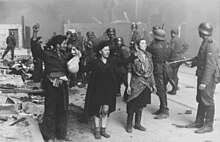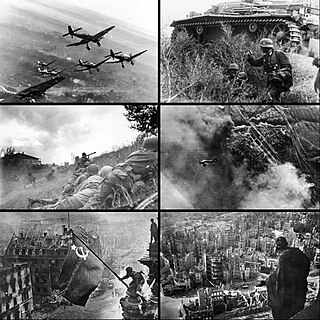| |||||
| Decades: | |||||
|---|---|---|---|---|---|
| See also: | Other events of 1943 History of Germany • Timeline • Years | ||||
Events in the year 1943 in Germany .
| |||||
| Decades: | |||||
|---|---|---|---|---|---|
| See also: | Other events of 1943 History of Germany • Timeline • Years | ||||
Events in the year 1943 in Germany .
Head of State and Chancellor


| | This section needs expansion. You can help by adding to it. (November 2011) |

The Luftwaffe was the aerial-warfare branch of the Wehrmacht before and during World War II. Germany's military air arms during World War I, the Luftstreitkräfte of the Imperial Army and the Marine-Fliegerabteilung of the Imperial Navy, had been disbanded in May 1920 in accordance with the terms of the 1919 Treaty of Versailles which banned Germany from having any air force.
1943 (MCMXLIII) was a common year starting on Friday of the Gregorian calendar, the 1943rd year of the Common Era (CE) and Anno Domini (AD) designations, the 943rd year of the 2nd millennium, the 43rd year of the 20th century, and the 4th year of the 1940s decade.

The European theatre of World War II was one of the two main theatres of combat during World War II. It saw heavy fighting across Europe for almost six years, starting with Germany's invasion of Poland on 1 September 1939 and ending with the Western Allies conquering most of Western Europe, the Soviet Union conquering most of Eastern Europe including the German capital Berlin, and Germany's unconditional surrender on 8 May 1945 although fighting continued elsewhere in Europe until 25 May. On 5 June 1945, the Berlin Declaration proclaiming the unconditional surrender of Germany to the four victorious powers was signed. The Allied powers fought the Axis powers on two major fronts, but there were other fronts varying in scale from the Italian campaign, to the Polish Campaign, as well as in a strategic bombing offensive and in the adjoining Mediterranean and Middle East theatre.

The Condor Legion was a unit of military personnel from the air force and army of Nazi Germany’s Wehrmacht which served with the Nationalist faction during the Spanish Civil War. The Condor Legion developed methods of strategic bombing that were used widely during the Second World War. The bombing of Guernica was the most infamous operation by the Condor Legion. Hugo Sperrle commanded the unit's aircraft formations and Wilhelm Ritter von Thoma commanded the ground element.
This is a list of aviation-related events from 1943:

The 3rd Infantry Division was an infantry division of the German Army that fought in World War II. The division was established under the cover name Wehrgauleitung Frankfurt in 1934 by expanding the 3rd Division of the Reichswehr. It was redesignated Kommandant von Frankfurt shortly afterward, and took on its bona fide name when the formation of the Wehrmacht was announced in October 1935. In March 1939 the division took part in the invasion and occupation of Czechoslovakia.
Events from the year 1940 in the United Kingdom. The year was dominated by Britain's involvement in the Second World War, which commenced in September the previous year, as well as the numerous enemy air raids on Britain and thousands of subsequent casualties. Although the war continued, Britain did triumph in the Battle of Britain and Nazi Germany's invasion attempt did not take place.
Ernst Hechler was a German bomber pilot and U-boat commander in World War II. He was a recipient of the Knight's Cross of the Iron Cross of Nazi Germany. Hechler is credited with the sinking of four ships for a total of 13,804 gross register tons (GRT), and with damaging one destroyer escort.

The Wehrmacht were the unified armed forces of Nazi Germany from 1935 to 1945. It consisted of the Heer (army), the Kriegsmarine (navy) and the Luftwaffe. The designation "Wehrmacht" replaced the previously used term Reichswehr and was the manifestation of the Nazi regime's efforts to rearm Germany to a greater extent than the Treaty of Versailles permitted.
Blitz Week was a period of United States Army Air Forces (USAAF) aerial bombardment during the 1943 Combined Bomber Offensive of World War II. Air raids were conducted on six of seven days as part of Operation Gomorrah, against targets such as the chemical plant at Herøya, Norway, which produced nitrates for explosives; and the AGO Flugzeugwerke AG plant at Oschersleben, Germany that assembled Focke-Wulf Fw 190s. The Kassel mission on July 28, 1943, was the first use of auxiliary external fuel tanks on the P-47 Thunderbolt.
Events in the year 1939 in Germany.
Events in the year 1893 in Germany.
Events in the year 1940 in Germany.
Events in the year 1941 in Germany.
Events in the year 1942 in Germany.
Events in the year 1944 in Germany.
Events in the year 1945 in Germany.
Events in the year 1914 in Germany.

Franz Kurowski was a German author of fiction and non-fiction who specialised in World War II topics. He is best known for producing apologist, revisionist and semi-fictional works on the history of the war, including the popular English-language series Panzer Aces and Infantry Aces.